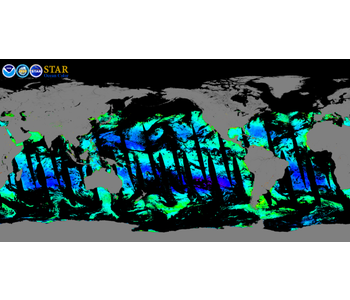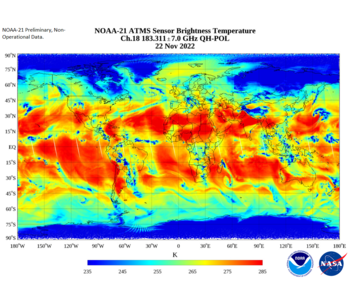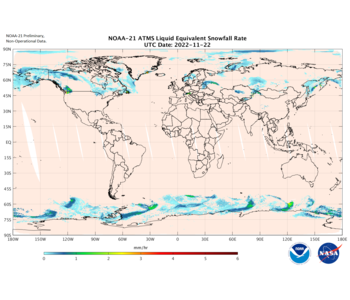STAR JPSS Website
NOAA-21 VIIRS Ocean Color First Light Image
Menghua Wang
06-Dec-22 - The STAR Ocean Color team has updated its OCView website to include imagery from NOAA-21. These data (which are non-operational) include imagery of chlorophyll concertration, true color imagery, and other parameters.
NOAA-21 VIIRS True Color First Light Image
VIIRS SDR Team
06-Dec-22" - The STAR VIIRS SDR team has produced first light imagery from the VIIRS visible bands. The image shows treu color imagery from December 5. VIIRS is the second instrument to be activated, with the VIIRS thermal bands, CRIS, and OMPS to follow in upcoming weeks.
NOAA-21 ATMS First Light Image
ATMS SDR Team
22-Nov-22 - STAR JPSS has produced first light imagery from the recently launched NOAA-21 satellite. The image selected shows the Channel 18 (183 Ghz) Brightness Temperature for the ascending node on November 21-22. ATMS, which is the first NOAA-21 instrument to be activated will be followed by CrIS, VIIRS, and OMPS in the coming month
NOAA-21 Snowfall Rate First Light Image
Huan Meng
22-Nov-22 - STAR JPSS has produced first light imagery from the recently launched NOAA-21 satellite. The image selected shows the ATMS-derived Snowfall Rate product for the ascending node on November 21-22. ATMS, which is the first NOAA-21 instrument to be activated will be followed by CrIS, VIIRS, and OMPS in the coming month.
NOAA-21 MIRS TPW First Light Image
Chris Grassotti
22-Nov-22 - STAR JPSS has produced first light imagery from the recently launched NOAA-21 satellite. The image selected shows the ATMS-derived MIRS Total Precipitable Water for the ascending node on November 21-22. ATMS, which is the first NOAA-21 instrument to be activated will be followed by CrIS, VIIRS, and OMPS in the coming month.
Latest JSTAR Updates
JPSS data now available in the cloud - 17 April 2024
JPSS operational data products, training materials, tools, sample
python scripts to read the data are accessible from NOAA Open Data
Dissemination (NODD).
- Amazon Web Services JPSS Main Page
- AWS NOAA-20
- AWS NOAA-21
- AWS SNPP
- JPSS on Google Cloud
- Microsoft Azure: Coming Soon
VIIRS Global Annual Surface Type (AST) - 31 August 2023 - The new VIIRS Annual Surface Type 2022 product (AST-2022, spatial resolution: 1 km) based on 2022 whole year surface reflectance data is ready for users to download at STAR FTP sites.
NetCDF version / Zip files:- VIIRS-AST-EMC20-GEO
NetCDF / Zip file - VIIRS-AST-IGBP17-GEO
NetCDF - Zip file - VIIRS-AST-IGBP17-SIN
NetCDF - Zip file
Each Zip file contains a *.bin, a *.hdr and a *readme.pdf file. For more information please contact Xiwu Zhan.
STAR JPSS Monthly Reports
- April 2024, (PDF, 8.48 MB)
- March 2024, (PDF, 7.04 MB)
- February 2024, (PDF, 7.68 MB)
- January 2024, (PDF, 9.09 MB)
- December 2023, (PDF, 10.53 MB)
- November 2023, (PDF, 491 KB)
- Report Archive
For more information, please write to Ingrid Guch / Lihang Zhou
Upcoming Events
- European Geosciences Union (EGU) General Assemblies 2024, Vienna, Austria, April 14-19, 2024





